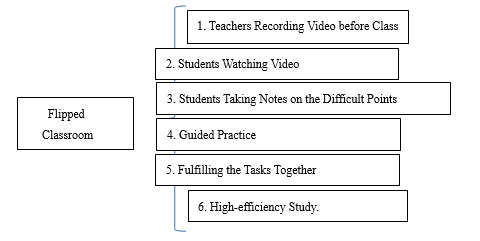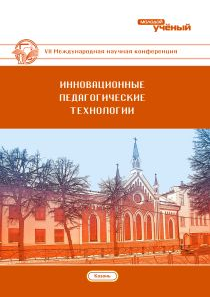Application of the flipped classroom in college English teaching
Рубрика: 3. Система образования
Опубликовано в
Дата публикации: 06.10.2017
Статья просмотрена: 79 раз
Библиографическое описание:
Лю, Сяолэй. Application of the flipped classroom in college English teaching / Сяолэй Лю, Yang Lin. — Текст : непосредственный // Инновационные педагогические технологии : материалы VII Междунар. науч. конф. (г. Казань, октябрь 2017 г.). — Казань : Бук, 2017. — С. 9-12. — URL: https://moluch.ru/conf/ped/archive/271/13051/ (дата обращения: 19.05.2024).
The flipped classroom is a new form of teaching. Students use modern information technology to watch video in advance on the platform and then solve problems in class. The application of this new teaching mode in college English teaching activates the circumstance of class, improves the students' understanding of English, improves the quality of teaching, and promotes the successful transition of the teaching mode. In a word, the emergence of the flipped classroom represents a great progress of the classroom teaching reform, which is worth promoting in college English teaching.
Key Words: Flipped Classroom, College English Teaching, Teaching Reform
1. Introduction
With the development of modern information technology, a variety of foreign language teaching software and computer-assisted instruction have emerged. Based on the micro class and MOOCs, the flipped classroom reversed the traditional teaching model by requiring students to watch the multimedia resources such as video and audio and then fulfill the online tests before class. And then in the class, teachers and students exchange views with each other so as to achieve the goal of teaching. In this paper, the author discussed the application of the flipped classroom in college English teaching from the perspective of its characteristics, the problems and challenges that may be encountered in the process of its implementation.
2. Flipped Classroom Teaching Mode
2.1 Definition of the Flipped Classroom
The flipped classroom, as a new term, also as a new teaching mode, was first proposed by Salman Khan in 2011. Sharman Khan believes that students’ learning by watching videos in the course of self-paced progress, interacting with teachers and receiving guidance makes the classroom more humanized [1]. In a nutshell, the flipped classroom means that teachers use modern information technology to pre-record lectures; learners spend after- class time watching the video, and then in the class teacher and learners exchange their views with each other so as to achieve the goal of teaching. It is a new form of teaching which reversed the traditional instructional design of learning in class.
2.2 Flipped Classroom Teaching Mode
On the basis of conceptual understanding, the author designed a conceptual map of the «flipped classroom» teaching mode:

3. Characteristics of the Flipped Classroom
(1) Change of the Role of the Teachers
First of all, in the flipped classroom, the teacher is no longer the instructor but the guider and facilitator. And students can play a dominant role in the class. Besides, teachers should skillfully utilize some organizational strategies for learning activities, such as problem-based learning, project-based learning, group discussions, game learning, and role play etc. [2]. Secondly, teachers are no longer the knowledge providers but the developers of video resources and providers of educational resources. Before class, for students’ better understanding of the knowledge, teachers need to provide students with necessary resources, such as instructional video, courseware and other network resources. And when students are in need of help, teachers can offer some support. Thus, teachers become the guider for students to obtain resources, utilize resources, process information and apply knowledge in the real situation.
(2) Change of the Role of Students
In the personalized learning, students do the self-paced learning under the flipped class teaching mode. They can decide time, location and how much to learn. Students are no longer the passive receiver of the knowledge; instead they play a leading role in the learning process. In the class, students complete the understanding and absorption of knowledge through group learning and collaborative learning [3]. Those who can rapidly master the knowledge will help those who are in need, thus assuming the role of teachers in teaching.
(3) Redistribution of the Classroom Time
Reducing teachers’ lecturing time and leaving more time for interactive activities is an important feature of the flipped classroom. In the flipped classroom, the teaching contents are completed by students before class through network technology. Increasing the interactivity between teachers and students without reducing the knowledge transfer can realize the depth of knowledge internalization, thus improving the learning efficiency [4].
(4) «Flipped Classroom» Improving interaction in learning
Flipping classroom greatly improves the interaction between teachers and students as well as between students themselves. Since students complete the learning before class, in class they mainly focus on discussing the problems with the teachers, in this way students may actively participate in the learning process. And teachers’ evaluation may effectively improve the interactivity. According to the teachers’ feedback, students may know their learning in an objective way and better control their study.
(5) Realizing Education Equity and Promoting the Integration and Optimization of Educational Resources
In today's world, any country or region has the uneven distribution of educational resources and there are the teaching differences between regions. As a product of the information age, the flipped class reflects the real demands of the society for knowledge and fair competition [5]. It has aroused extensive and strong resonance in the educational field. By using the network and modern information technology, teachers can integrate the best educational resources into the micro-class for students to study by themselves, thus making up for the differences between the regions and letting different levels of students enjoy the best quality of the elite educational resources. In this way, it breaks the monopoly of high-quality educational resources to a certain extent and let students in different countries or regions have the opportunity to receive the best quality education. The reorganization and configuration of educational resources in the flipped class is incomparable to the traditional teaching mode. In the process of the re integration and optimal allocation of educational resources, the flipped classroom helped to realize the equity of education.
4. Necessity of the Application of the Flipped Classroom in College English Teaching
Compared with the traditional teaching mode, the flipped classroom teaching mode has its obvious advantages: (1) It greatly expands the classroom time and space. Unlike the traditional classroom teaching, flipped classroom is no longer confined within a specified period of time (class) and space (classroom), which enables some special students to arrange their own time and place and to learn till they master the knowledge instead of going to the fixed place at fixed time. (2) It greatly promotes the realization of teaching objectives. Students’ abilities vary. The traditional model cannot teach students in accordance with their aptitude. And once the students distracted, they cannot keep pace with the teaching. Thus teaching effects will be less than satisfactory. Flipped class achieves group teaching with videos before class. Students can choose learning content according to their needs and they can fast forward video or replay. The internalization of knowledge is guided by the teacher in the classroom, which can better satisfy the needs of different students. (3) It greatly promotes the cultivation of students' ability. Flipped class attaches more importance to interaction, stimulates students' interest, encourages students to actively participate in the classroom discussion, and is especially beneficial to students’ critical thinking ability and integrating theory with practice. At the same time, students’ cooperation ability and communication skills can be trained.
5. Conclusion
Compared with the traditional classroom, the flipped classroom puts more emphasis on the self-learning and interactivity. And the abundant network resources present the knowledge in a vivid way. At present, college English teaching in our country faces many problems such as complicated student group, compressed teaching hours and so on. Thus, it is imperative to reform. From the perspective of the foreign language learners, the flipped classroom tries to find a breakthrough in the teaching philosophy, makes students willing to learn and becomes a new attempt at the reform of college English teaching.
References:
- 张跃国,张渝江, 透视“翻转课堂”[J], 中小学信息技术教育, 2012(3): 9–10;
- 卢海燕, 基于微课的“翻转课堂”模式在大学英语教学中应用的可行性分析 [J], 外语电化教学,2014(7):33–36;
- Milman,N. B. The Flipped Classroom Strategy: What is it and How Can it Best be Used? [M]. Greenwich: Distance Learning,2012: 85–87;
- 马秀麟,赵国庆,邬彤, 大学信息技术公共课翻转课堂教学的实证研究[J], 远程教育杂志,2013(1):80–84;
- 崔艳辉, 王轶, 翻转课堂及其在大学英语教学中的应用[J], 中国电化教育,2014(11): 116–120.











